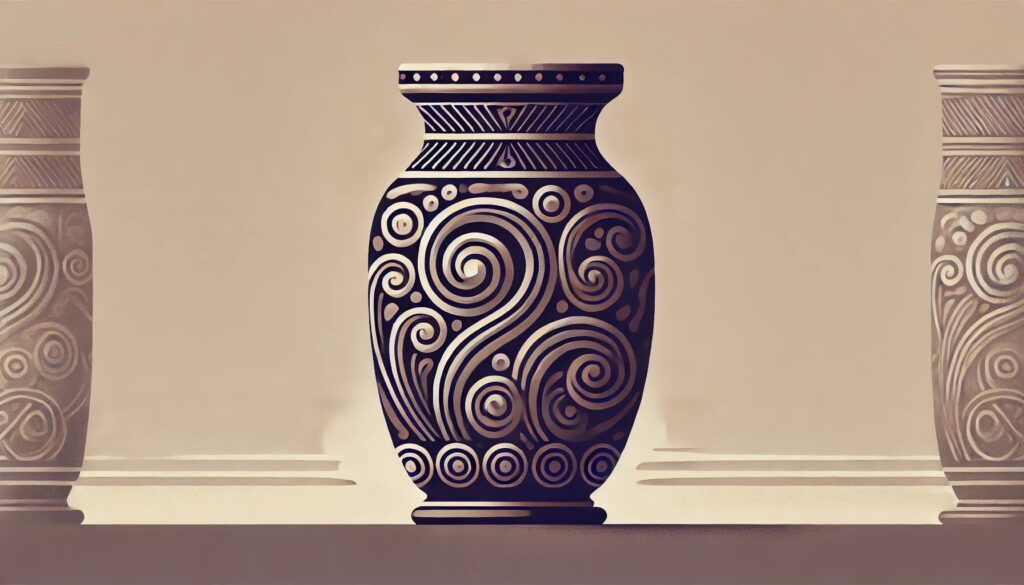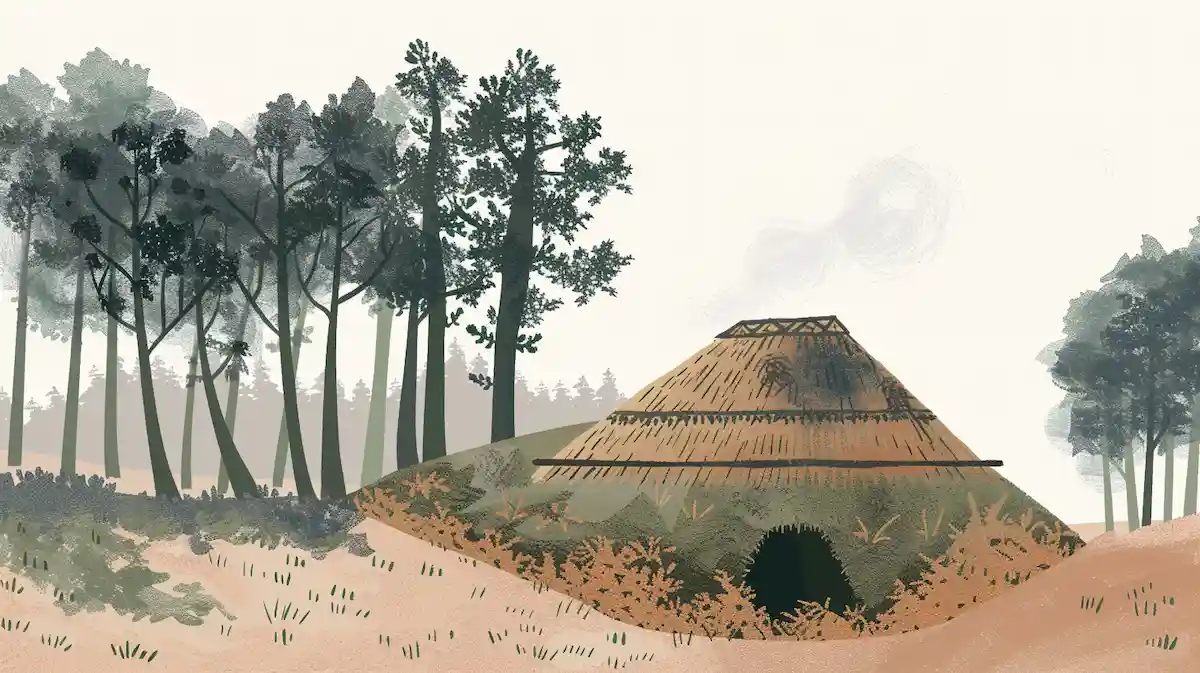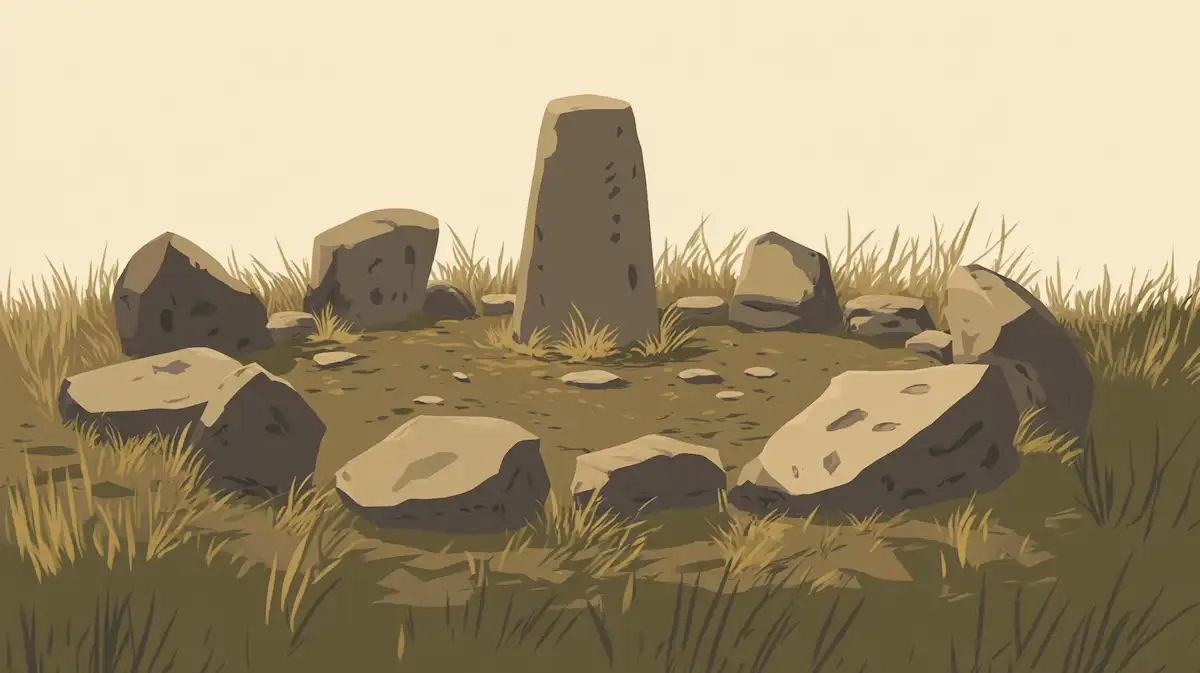縄文時代を英語で説明・紹介するための基本情報と、英会話に役立つ表現をシンプルでわかりやすい英語で紹介します。
英会話ダイアローグ・概要・10の質問を通して、縄文時代に関する英語表現を学びます。
英語
英会話ダイアローグを読む前に知っておくと良い前提知識と情報です。
- 縄文時代の基本情報
- 約13,000年前から約2,400年前(紀元前11,000年頃~紀元前300年頃)
- 土器の表面に縄目模様(縄文)がついていることから名付けられた
- 狩猟・採集・漁労を基盤とし、農耕は行っていなかった
- 地面を掘り下げた「竪穴住居」に住んでいた
- 縄文時代の特徴
- 縄文土器: 世界最古級の土器で、煮炊きや貯蔵に使用、縄目模様が特徴
- 土偶: 主に女性を模した土製の人形で、豊穣や安産を祈る祭祀に使われた
- 平等な社会: 身分の差がほとんどなく、共同体での協力が重視された
- 交易: 黒曜石などの物品が遠距離で交易されていた
- 世界遺産
- 2021年、「北海道・北東北の縄文遺跡群」として17の遺跡がユネスコ世界文化遺産に登録
- 代表的な遺跡
- 三内丸山遺跡(青森県): 大規模な集落で、長期間定住した跡が残る
- 大湯環状列石(秋田県): 儀式用とされるストーンサークルが特徴
2人が縄文時代について話しています。
縄文土器の特徴、狩猟採集による生活、竪穴住居での暮らし、代表的な遺跡の三内丸山遺跡などを話題にしています。
会話 / dialogue

Hey Key, I’ve been reading a bit about Japanese history lately. There’s one period I find really fascinating—the Jomon Period. Do you know much about it?

Oh, the Jomon Period? Yeah, I know a little. It’s one of Japan’s oldest periods, starting about 13,000 years ago. What caught your interest?

I saw pictures of those pots with rope-like patterns. They looked amazing! Is that where the name “Jomon” comes from?

Exactly! The word “Jomon” means “rope pattern” in Japanese. It refers to the designs on their pottery. What’s even cooler is that these are some of the oldest pottery in the world.

That’s incredible. What kind of life did they have back then?

Well, they didn’t farm like later periods. Instead, they hunted animals, caught fish, and gathered nuts and fruits. They lived in pit dwellings, which were partly dug into the ground. It’s interesting because they managed to settle down without farming.

So they were already living in villages? That sounds advanced for a hunter-gatherer society.

Yeah, it was. Their villages often had circular layouts with a central area for activities. They also made tools from stone, bone, and wood, and they were really skilled craftsmen.

Speaking of craftsmanship, I also saw pictures of these strange clay figures. What are they?

Ah, those are called dogu. They were likely used in rituals, maybe for praying for good harvests or safe childbirth. Some of them have really unique shapes, almost like modern art!

That’s fascinating. Were there any major Jomon sites discovered?

Definitely. One of the most famous is Sannai-Maruyama in Aomori Prefecture. It’s a huge site with evidence of long-term settlement, including large buildings and storage pits. Another is Oyu Stone Circles in Akita, which might have been used for ceremonies.

Oh, I think I’ve heard of those! Didn’t some of these sites become World Heritage Sites recently?

You’re right. In 2021, 17 Jomon sites in northern Japan, including Sannai-Maruyama, were added to UNESCO’s list. It’s a big deal because it highlights their cultural importance.

That’s amazing. So, they didn’t farm, but they seemed to have a really advanced society in other ways.

Exactly. They adapted to their environment and lived in harmony with nature. They even traded materials like obsidian over long distances.

I’d love to visit one of these sites. Do you think there are places where I can experience what life was like during the Jomon Period?

Definitely. Many sites, like Sannai-Maruyama, have museums or reconstructed buildings where you can learn more. You should check it out next time you’re up north.

I’ll do that for sure. Thanks for sharing all this, Key. The Jomon Period feels like such a rich part of history.

It really is. The more you learn about it, the more you’ll see how advanced and unique their culture was. Let me know if you want to explore it together someday!

Deal! I’ll start planning a trip soon.
概要 / Overview
「縄文時代」について、理解を深めるための「英語での概要」です。
縄文時代

Introduction to the Jomon Period
The Jomon Period is one of the oldest periods in Japanese history. It lasted from about 13,000 years ago to 2,400 years ago, which is around 11,000 BCE to 300 BCE. The name “Jomon” means “rope pattern” in Japanese and comes from the designs found on pottery made during this time. The Jomon Period is famous for its unique culture, which combined a hunter-gatherer lifestyle with early forms of settlement.
Life During the Jomon Period
People in the Jomon Period lived by hunting, fishing, and gathering nuts and fruits. They didn’t farm like people in later periods, but they were able to live in one place for long periods. Their homes, called pit dwellings, were partly dug into the ground to keep them warm in winter and cool in summer. They lived in villages, often arranged in a circular layout with a central space for activities.
Jomon Pottery and Tools
Jomon pottery is some of the oldest in the world. It was used for cooking, storing food, and sometimes for rituals. The rope-like patterns on the pottery are very artistic and unique. People also made tools from stone, wood, and bone, including arrowheads, fishing hooks, and knives. These tools show how skilled and creative the Jomon people were.
Spiritual Life and Rituals
The Jomon people had a rich spiritual life. They believed in the spirits of nature, a practice called animism. They created clay figurines called dogu, which were likely used in rituals. Dogu often look like women and may have been symbols of fertility or life. These objects are an important part of Jomon culture and art.
Famous Jomon Sites
Many Jomon sites have been discovered in Japan. One of the most famous is Sannai-Maruyama in Aomori Prefecture, which was a large village with many buildings and storage pits. Another is Oyu Stone Circles in Akita Prefecture, which were likely used for ceremonies. In 2021, 17 Jomon sites in northern Japan were registered as UNESCO World Heritage Sites.
Conclusion
The Jomon Period is an important part of Japanese history. It shows how people lived in harmony with nature and developed a unique culture. Their pottery, tools, and rituals still inspire us today. Visiting Jomon sites is a great way to learn more about this fascinating period.
10の質問 / 10 questions
「縄文時代」について、理解を深めるための「英語での10の質問」です。
1: What is the Jomon Period?
The Jomon Period is one of the oldest periods in Japanese history. It lasted from about 13,000 years ago to 2,400 years ago and is known for its pottery with rope-like patterns.
2: Why is it called the Jomon Period?
The name “Jomon” means “rope pattern” in Japanese. It comes from the designs found on pottery made during this time.
3: How did people live during the Jomon Period?
People hunted animals, caught fish, and gathered nuts and fruits. They lived in pit dwellings and settled in villages.
4: What are pit dwellings?
Pit dwellings are homes partly dug into the ground. They kept the inside cool in summer and warm in winter.
5: What is Jomon pottery?
Jomon pottery is some of the oldest in the world. It was used for cooking, storing food, and sometimes for rituals. It has unique rope-like patterns.
6: What are dogu?
Dogu are clay figurines made during the Jomon Period. They were likely used in rituals and often represent women or fertility symbols.
7: Did Jomon people grow crops?
No, they did not grow crops like later periods. Instead, they lived as hunter-gatherers, relying on nature for food.
8: What are some famous Jomon sites?
Famous sites include Sannai-Maruyama in Aomori Prefecture, a large village site, and Oyu Stone Circles in Akita Prefecture, likely used for ceremonies.
9: Are any Jomon sites World Heritage Sites?
Yes, in 2021, 17 Jomon sites in northern Japan were added to UNESCO’s World Heritage list for their cultural importance.
10: Why is the Jomon Period important?
The Jomon Period shows how early humans adapted to their environment, created unique pottery and tools, and lived in harmony with nature.

和訳付
会話 / dialogue

Hey Key, I’ve been reading a bit about Japanese history lately. There’s one period I find really fascinating—the Jomon Period. Do you know much about it?
ねえキー、最近日本の歴史について少し読んでたんだけど、「縄文時代」って本当に面白そうだよ。詳しく知ってる?

Oh, the Jomon Period? Yeah, I know a little. It’s one of Japan’s oldest periods, starting about 13,000 years ago. What caught your interest?
ああ、縄文時代ね?少しだけ知ってるよ。日本で最も古い時代の一つで、約1万3千年前に始まったんだ。何が興味を引いたの?

I saw pictures of those pots with rope-like patterns. They looked amazing! Is that where the name “Jomon” comes from?
縄目模様がついた壺の写真を見たんだ。すごく素敵だったよ!「縄文」って、その模様から来てるの?

Exactly! The word “Jomon” means “rope pattern” in Japanese. It refers to the designs on their pottery. What’s even cooler is that these are some of the oldest pottery in the world.
その通り!「縄文」って日本語で「縄目模様」を意味するんだよ。その土器の模様を指してるんだ。さらにすごいのは、これが世界でも最古級の土器の一つだってことだね。

That’s incredible. What kind of life did they have back then?
それはすごいね。じゃあ、当時の人たちはどんな暮らしをしてたの?

Well, they didn’t farm like later periods. Instead, they hunted animals, caught fish, and gathered nuts and fruits. They lived in pit dwellings, which were partly dug into the ground. It’s interesting because they managed to settle down without farming.
そうだね、後の時代みたいに農業はしてなかったよ。その代わりに、動物を狩ったり、魚を捕ったり、木の実や果物を集めたりしてたんだ。竪穴住居っていう地面を少し掘り下げた家に住んでたんだよ。農業なしで定住生活をしてたのが面白いよね。

So they were already living in villages? That sounds advanced for a hunter-gatherer society.
じゃあ、すでに村みたいなところで暮らしてたんだ?狩猟採集社会にしては進んでる感じがするね。

Yeah, it was. Their villages often had circular layouts with a central area for activities. They also made tools from stone, bone, and wood, and they were really skilled craftsmen.
うん、そうだよ。村はよく円形に配置されていて、中央に活動するスペースがあったんだ。それに石や骨、木で道具を作ってて、本当に手先が器用だったんだよ。

Speaking of craftsmanship, I also saw pictures of these strange clay figures. What are they?
職人技といえば、奇妙な形の土製の人形の写真も見たよ。あれって何?

Ah, those are called dogu. They were likely used in rituals, maybe for praying for good harvests or safe childbirth. Some of them have really unique shapes, almost like modern art!
ああ、それは「土偶」って呼ばれるものだよ。たぶん儀式で使われたんだと思う。豊作や安産を祈るためかもしれないね。中には現代アートみたいなユニークな形のものもあるんだ。

That’s fascinating. Were there any major Jomon sites discovered?
それは興味深いね。縄文時代の主要な遺跡って発見されてるの?

Definitely. One of the most famous is Sannai-Maruyama in Aomori Prefecture. It’s a huge site with evidence of long-term settlement, including large buildings and storage pits. Another is Oyu Stone Circles in Akita, which might have been used for ceremonies.
もちろんだよ。有名なのは青森県の三内丸山遺跡かな。長期間住んでた証拠がたくさんあって、大型建物や貯蔵穴も見つかってる。それから秋田の大湯環状列石もあって、儀式に使われたんじゃないかって言われてるよ。

Oh, I think I’ve heard of those! Didn’t some of these sites become World Heritage Sites recently?
あ、それ聞いたことある!最近、これらの遺跡のいくつかが世界遺産になったんじゃない?

You’re right. In 2021, 17 Jomon sites in northern Japan, including Sannai-Maruyama, were added to UNESCO’s list. It’s a big deal because it highlights their cultural importance.
その通り。2021年に、三内丸山を含む北日本の17の縄文遺跡がユネスコのリストに登録されたんだ。縄文文化の重要性を示す大きな出来事だよ。

That’s amazing. So, they didn’t farm, but they seemed to have a really advanced society in other ways.
すごいね。農業はしてなかったけど、他の面ではかなり進んだ社会だったんだね。

Exactly. They adapted to their environment and lived in harmony with nature. They even traded materials like obsidian over long distances.
その通り。彼らは環境に適応して自然と調和して暮らしてたんだ。それに黒曜石みたいな材料を遠くまで交易してたみたいだよ。

I’d love to visit one of these sites. Do you think there are places where I can experience what life was like during the Jomon Period?
そういう遺跡を訪れてみたいな。縄文時代の生活を体験できる場所ってあると思う?

Definitely. Many sites, like Sannai-Maruyama, have museums or reconstructed buildings where you can learn more. You should check it out next time you’re up north.
もちろんだよ。三内丸山みたいな遺跡には、博物館や復元された建物があって、いろいろ学べるんだ。次に北日本に行くときはぜひ行ってみて。

I’ll do that for sure. Thanks for sharing all this, Key. The Jomon Period feels like such a rich part of history.
絶対そうするよ。いろいろ教えてくれてありがとう、キー。縄文時代って本当に歴史の豊かな部分だね。

It really is. The more you learn about it, the more you’ll see how advanced and unique their culture was. Let me know if you want to explore it together someday!
本当にそうだね。学べば学ぶほど、縄文文化がどれだけ進んでいてユニークだったか分かるよ。いつか一緒に探索しようね!

Deal! I’ll start planning a trip soon.
いいね!すぐに旅行計画を立てるよ。
概要 / Overview
縄文時代

Introduction to the Jomon Period
The Jomon Period is one of the oldest periods in Japanese history. It lasted from about 13,000 years ago to 2,400 years ago, which is around 11,000 BCE to 300 BCE. The name “Jomon” means “rope pattern” in Japanese and comes from the designs found on pottery made during this time. The Jomon Period is famous for its unique culture, which combined a hunter-gatherer lifestyle with early forms of settlement.
縄文時代の紹介
縄文時代は日本の歴史の中で最も古い時代の一つです。約13,000年前から約2,400年前、つまり紀元前11,000年頃から紀元前300年頃まで続きました。「縄文」という名前は、この時代に作られた土器に見られる縄目模様に由来します。縄文時代は、狩猟採集生活と初期の定住生活を組み合わせた独自の文化で知られています。
Life During the Jomon Period
People in the Jomon Period lived by hunting, fishing, and gathering nuts and fruits. They didn’t farm like people in later periods, but they were able to live in one place for long periods. Their homes, called pit dwellings, were partly dug into the ground to keep them warm in winter and cool in summer. They lived in villages, often arranged in a circular layout with a central space for activities.
縄文時代の生活
縄文時代の人々は、狩猟、漁労、木の実や果物の採集をして生活していました。後の時代のように農業は行いませんでしたが、長期間同じ場所に住むことができました。彼らの住居は「竪穴住居」と呼ばれ、冬は暖かく、夏は涼しくなるように地面を掘り下げて作られていました。また、村は円形に配置され、中央には共同の活動スペースがありました。
Jomon Pottery and Tools
Jomon pottery is some of the oldest in the world. It was used for cooking, storing food, and sometimes for rituals. The rope-like patterns on the pottery are very artistic and unique. People also made tools from stone, wood, and bone, including arrowheads, fishing hooks, and knives. These tools show how skilled and creative the Jomon people were.
縄文土器と道具
縄文土器は世界でも最古級のものです。調理、食物の保存、そして時には儀式にも使われました。この土器に見られる縄目模様は非常に芸術的でユニークです。また、石、木、骨を使って矢じり、釣り針、ナイフなどの道具も作りました。これらの道具は、縄文人がどれほど器用で創造的だったかを示しています。
Spiritual Life and Rituals
The Jomon people had a rich spiritual life. They believed in the spirits of nature, a practice called animism. They created clay figurines called dogu, which were likely used in rituals. Dogu often look like women and may have been symbols of fertility or life. These objects are an important part of Jomon culture and art.
精神的な生活と儀式
縄文人は豊かな精神文化を持っていました。彼らは自然の精霊を信じており、この信仰は「アニミズム」と呼ばれています。彼らは「土偶」と呼ばれる土製の人形を作り、儀式に使ったと考えられています。土偶は女性を模しているものが多く、豊穣や生命の象徴だったかもしれません。これらの物は縄文文化と芸術の重要な一部です。
Famous Jomon Sites
Many Jomon sites have been discovered in Japan. One of the most famous is Sannai-Maruyama in Aomori Prefecture, which was a large village with many buildings and storage pits. Another is Oyu Stone Circles in Akita Prefecture, which were likely used for ceremonies. In 2021, 17 Jomon sites in northern Japan were registered as UNESCO World Heritage Sites.
有名な縄文遺跡
日本では多くの縄文遺跡が発見されています。最も有名な遺跡の一つは青森県の「三内丸山遺跡」で、多くの建物や貯蔵穴が見つかった大規模な集落です。もう一つは秋田県の「大湯環状列石」で、儀式に使われたと考えられています。2021年には、北日本にある17の縄文遺跡がユネスコの世界文化遺産に登録されました。
Conclusion
The Jomon Period is an important part of Japanese history. It shows how people lived in harmony with nature and developed a unique culture. Their pottery, tools, and rituals still inspire us today. Visiting Jomon sites is a great way to learn more about this fascinating period.
結論
縄文時代は日本の歴史の重要な部分です。この時代は、人々が自然と調和して暮らし、独自の文化を発展させたことを示しています。縄文土器や道具、儀式は今日でも私たちに多くのインスピレーションを与えてくれます。縄文遺跡を訪れることで、この魅力的な時代についてさらに学ぶことができます。
10の質問 / 10 questions
1: What is the Jomon Period?
縄文時代とは何ですか?
The Jomon Period is one of the oldest periods in Japanese history. It lasted from about 13,000 years ago to 2,400 years ago and is known for its pottery with rope-like patterns.
縄文時代は日本の歴史の中で最も古い時代の一つです。約13,000年前から約2,400年前まで続き、縄目模様の土器で知られています。
2: Why is it called the Jomon Period?
なぜ縄文時代と呼ばれるのですか?
The name “Jomon” means “rope pattern” in Japanese. It comes from the designs found on pottery made during this time.
「縄文」という名前は日本語で「縄目模様」を意味します。この時代に作られた土器の模様から来ています。
3: How did people live during the Jomon Period?
縄文時代の人々はどのように生活していましたか?
People hunted animals, caught fish, and gathered nuts and fruits. They lived in pit dwellings and settled in villages.
人々は動物を狩り、魚を捕り、木の実や果物を集めて生活していました。彼らは竪穴住居に住み、村に定住していました。
4: What are pit dwellings?
竪穴住居とは何ですか?
Pit dwellings are homes partly dug into the ground. They kept the inside cool in summer and warm in winter.
竪穴住居は地面を少し掘り下げて作られた家です。夏は涼しく、冬は暖かいという特徴があります。
5: What is Jomon pottery?
縄文土器とは何ですか?
Jomon pottery is some of the oldest in the world. It was used for cooking, storing food, and sometimes for rituals. It has unique rope-like patterns.
縄文土器は世界最古級の土器です。調理や食物の保存、時には儀式にも使われました。独特の縄目模様が特徴です。
6: What are dogu?
土偶とは何ですか?
Dogu are clay figurines made during the Jomon Period. They were likely used in rituals and often represent women or fertility symbols.
土偶は縄文時代に作られた土製の人形です。おそらく儀式で使われ、女性や豊穣の象徴を表していることが多いです。
7: Did Jomon people grow crops?
縄文時代の人々は作物を栽培していましたか?
No, they did not grow crops like later periods. Instead, they lived as hunter-gatherers, relying on nature for food.
いいえ、後の時代のように作物を栽培してはいませんでした。その代わりに狩猟採集民として自然の恵みに頼っていました。
8: What are some famous Jomon sites?
有名な縄文遺跡には何がありますか?
Famous sites include Sannai-Maruyama in Aomori Prefecture, a large village site, and Oyu Stone Circles in Akita Prefecture, likely used for ceremonies.
有名な遺跡には、青森県の大規模な集落跡である三内丸山遺跡や、秋田県の儀式に使われたとされる大湯環状列石があります。
9: Are any Jomon sites World Heritage Sites?
縄文遺跡の中で世界遺産に登録されているものはありますか?
Yes, in 2021, 17 Jomon sites in northern Japan were added to UNESCO’s World Heritage list for their cultural importance.
はい、2021年に北日本の17の縄文遺跡がユネスコの世界文化遺産リストに登録されました。これらは文化的重要性が評価されています。
10: Why is the Jomon Period important?
縄文時代はなぜ重要ですか?
The Jomon Period shows how early humans adapted to their environment, created unique pottery and tools, and lived in harmony with nature.
縄文時代は、初期の人類が環境に適応し、独自の土器や道具を作り、自然と調和して暮らしていたことを示しています。

words & phrases
英会話ダイアローグと関連情報に出てきた単語・フレーズです(例文は各3つ)。

pottery : 名詞
意味: 陶器、土器。Objects made of clay and hardened by heat, used for cooking, storage, or decoration.
(縄文時代の土器は縄目模様が特徴で、調理や保存、儀式に使われた)
例文:
- Jomon pottery is known for its rope-like patterns.
「縄文土器は縄目模様で知られています。」 - She collects ancient pottery from various cultures.
「彼女はさまざまな文化の古代陶器を集めています。」 - The museum has a beautiful pottery exhibition.
「その博物館には美しい陶器展があります。」
dwelling : 名詞
意味: 住居。A place where people live, such as a house or an apartment.
(縄文時代の竪穴住居は、地面を掘り下げて作られた住居のことを指す)
例文:
- Pit dwellings were common in the Jomon Period.
「竪穴住居は縄文時代によく見られました。」 - The old dwelling was made of wood and straw.
「その古い住居は木とわらで作られていました。」 - Many dwellings in this area are over 100 years old.
「この地域の多くの住居は100年以上の歴史があります。」
dig : 動詞
意味: 掘る。To break up and move soil to create a hole or uncover something.
(竪穴住居を作るために地面を掘り下げる行為を指す)
例文:
- People in the Jomon Period dug into the ground to make pit dwellings.
「縄文時代の人々は竪穴住居を作るために地面を掘りました。」 - Let’s dig a hole to plant the tree.
「木を植えるために穴を掘りましょう。」 - They are trying to dig up artifacts from the ancient site.
「彼らは古代遺跡から遺物を掘り出そうとしています。」
settle down : 動詞句
意味: 落ち着く、定住する。To start living in one place permanently or to begin a calm and stable life.
(縄文時代の人々が狩猟採集生活から定住生活に移行したことを指す)
例文:
- Jomon people began to settle down in villages.
「縄文時代の人々は村に定住し始めました。」 - After years of travel, he decided to settle down in the countryside.
「何年も旅をした後、彼は田舎に定住することに決めました。」 - Let’s finish moving, and then we can settle down.
「引っ越しを終えたら、落ち着けるね。」
craftsmanship : 名詞
意味: 職人技、技巧。Skill in making things, especially by hand, with great care and detail.
(縄文時代の土器や道具に見られる高度な職人技を指す)
例文:
- The pottery from the Jomon Period shows incredible craftsmanship.
「縄文時代の土器には驚くべき職人技が見られます。」 - Her craftsmanship in jewelry design is outstanding.
「彼女の宝飾デザインにおける職人技は見事です。」 - This sculpture is a fine example of ancient craftsmanship.
「この彫刻は古代の職人技の素晴らしい例です。」
詳細情報 / Further Info
関連記事(三内丸山遺跡)

